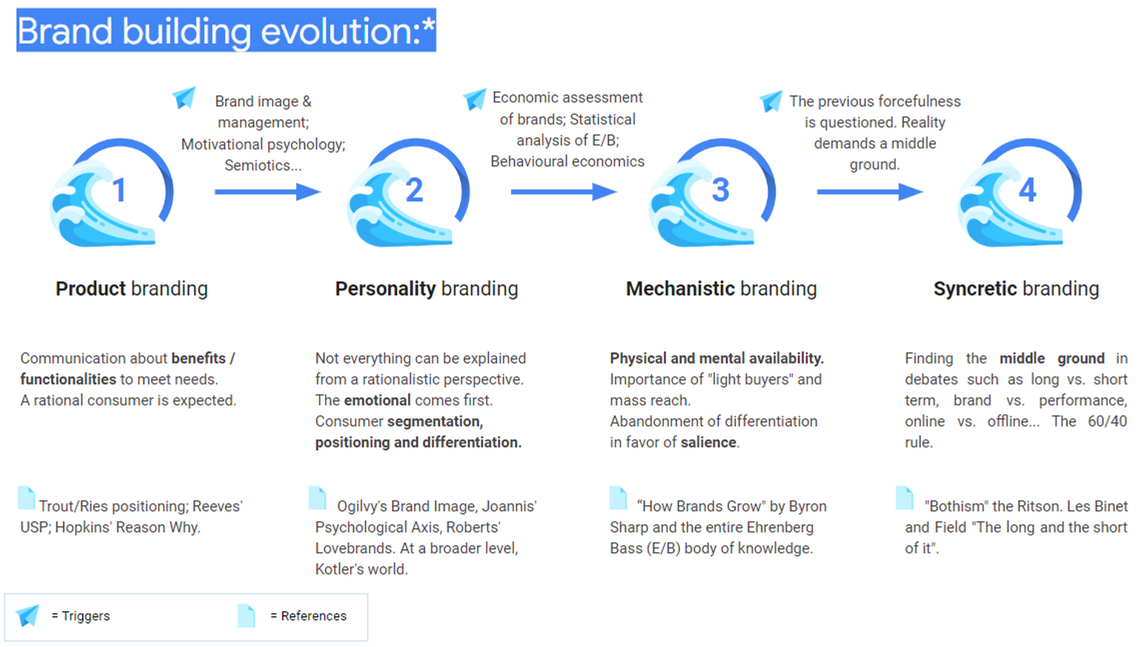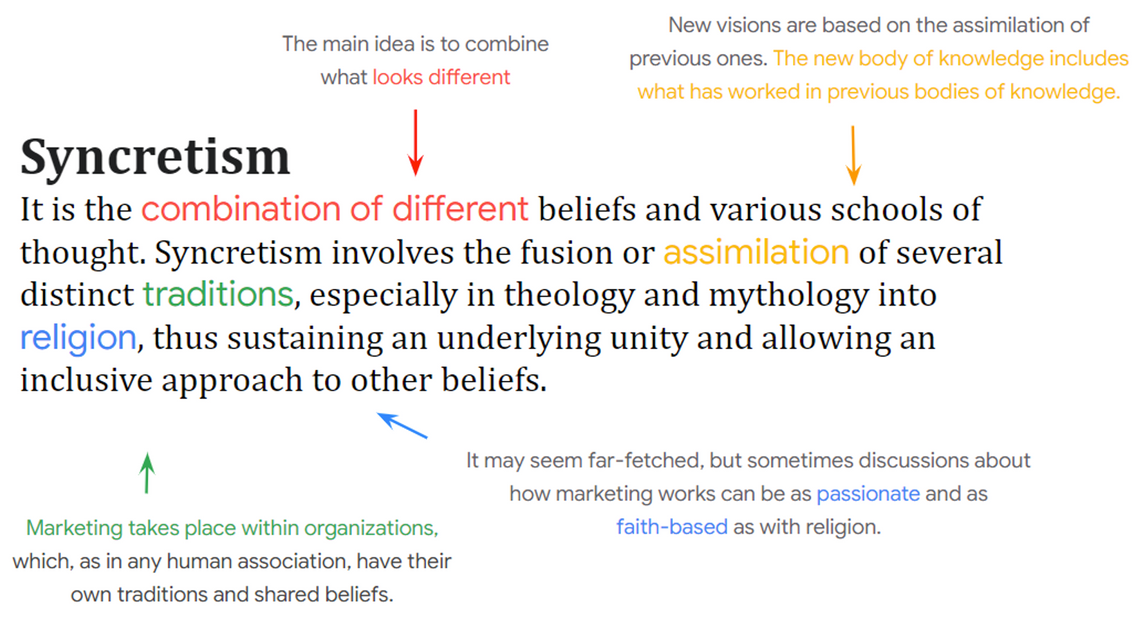Syncretism in action: A brief review of brand building and measurement theories
This two part article reviews four waves of evolution in brand building theories and the interrelated changes in brand health measurement methodologies.

Article series
Syncretism in action
- Syncretism in action: A brief review of brand building and measurement theories
- Syncretism in action: Implications on brand image measurement
In this two part article, we review four waves of evolution in brand-building theories and the interrelated changes in brand health measurement methodologies. The authors are aware there is a huge breadth to both fields. Our approach tries to be as honest and useful as possible within the pragmatic limitations of our knowledge and the length of the article.
Brand building theories evolution
The ways in which effective communication for brand building and sales have been explained have evolved over the decades. Broadly speaking, we can describe four schools of thought in this regard[1].
The first one is focused on the product. We're talking about the 1930s-40s-50s in the USA, with ideas like Reeves' “Unique Selling Proposition” (USP), Trout/Ries' “Positioning”, or the “Reason Why” from Hopkins. These communication paradigms emphasise the importance of focusing on specific aspects of the product's functionality and insist that with a message of superiority or differentiation, brands are giving consumers a "reason" to choose their product.
The second wave comes as a counterproposal to this "rationalist" theory, arriving in the 1960s and 1970s, first in the United States and then in the rest of the world, where schools that spoke about the personality of brands began to dominate and communication from the functional aspect was reduced. The triggers at the theoretical level were the use of semiotics and motivational psychology, in addition to the birth of "brand management" in companies. From there, communication theories like Ogilvy's “Brand Image”, Joannis' “Psychological Axis”, Séguéla's “Star Strategy”, or the more recent Kevin Roberts' “Lovebrands” emerged.
The third wave came in the 2010s, with Byron Sharp's[2] "How Brands Grow" books. The novel element introduced is the rigorous statistical analysis of actual consumer behaviour, particularly through household panels. In addition to this analysis of purchasing behaviour, the growing focus on effectiveness and persuasive communication, or the economic assessment of brands, both with a numerical component that the previous waves lacked, also triggered this evolution. Additionally, it was at that time that Behavioural Economics began to become popular as a tool for understanding the complexity of purchasing decisions. The previous schools of communication were criticised for their lack of rigour in experimental testing. This led to a model of brand creation based on both physical and mental availability, which banished the mysticism of brand image, segmentation and positioning. We could coin this third wave as the "mechanistic" one.
The authors of this paper have called the fourth and current wave "syncretic". Whereas before, we had paradigms that followed one another with a "clean slate", what we see now is that human complexity requires an explanation that brings together the best ideas that have been obtained over the decades.
A reference to this wave can be considered the work of Les Binet and Peter Field, who analysed the database of the IPA Effectiveness Awards in the UK, shown in publications such as "The Long and the Short of It". In it, we can see that not everything can be reduced to false dichotomies such as short vs. long term or performance vs. branding… To sell today and grow tomorrow, all these variables must be worked in harmony, in what Mark Ritson calls "bothism". They also show the importance of adapting to the evolution of the context, such as the multiplicity of channels that digitalisation has brought us. Les Binet, for example, analyses brand searches on Google and how they correlate with their market share. These searches performed by consumers are a good approximation of the "mental availability" indicator developed by Byron Sharp.
In this table, we summarise the four waves described, with their main theories and the triggers of the successive evolutions.
 *Inspired mainly from the work "Strategic Advertising Mechanisms" by Jorge Fernández and complemented with the authors' own ideas. It is not possible to pigeonhole all schools and theories without somehow falling into simplification.
*Inspired mainly from the work "Strategic Advertising Mechanisms" by Jorge Fernández and complemented with the authors' own ideas. It is not possible to pigeonhole all schools and theories without somehow falling into simplification.
About syncretism
All organisations that really engage in the practice of brand building have a syncretic version of communication. There are no paradigms or dogmatisms but rather a sum of those ideas that have been working. As our understanding of how consumers make decisions advances, the best companies abandon those aspects that are shown to be less relevant and adopt those that will help them sell more. What is ultimately implemented is a beautiful and chaotic sum of concepts superior to any single theory.

This is the result of several factors:
The complexity of human nature, where disciplines and points of view have to be added in order to explain behaviour
The changes in the context in which consumers live, which triggers the need to revisit theories
The relative youth of the discipline that studies consumer behaviour
Think, for example, of the old discipline of Concept Writing, which still survives. It has a three-paragraph structure of 1) insight with the tension to be resolved, 2) benefit provided by the brand and 3) reason to believe. Well, the “tension to resolve” is a concept from Joannis (personality school). The “benefit” clearly sounds like Reeves' USP (product school), and the “Reason Why” comes from Hopkins (product school).
At a broader level, the companies that have the most sophisticated marketing are able to synthesise what we know about rational and irrational consumer behaviour, statistical analysis of consumer panel data (with its “double jeopardy[3]...), understand the point of sale to help that consumer who buys in fast mode, understand the positioning of their brands in the minds of consumers... What they do is the sum of the best we have learned over the decades.
The behaviour and thinking of companies like Procter & Gamble, one of the organisations with the longest tradition in branding, is interesting. In the book "Playing to Win" by the company's two-time CEO A.G. Lafley, he talks about the different branding doctrines that followed in his company. Lafley talks about the different brand-building doctrines that followed in his company. The "Brand Building Framework - BBF": version 1.0 appeared in 1999, 2.0 in 2003, 3.0 in 2006 and 4.0 in 2021. Lafley prefaced the Lovemarks book by Kevin Roberts, a clear exponent of 2nd wave branding theories, just at the time of his BBF 3.0. Years later, at the time of BBF 4.0, we see that P&G is a patron of the Ehrenberg Bass Institute and has adopted some of its ideas (3rd wave). Each BBF was not an amendment of the previous one but a genuine move towards best practices in marketing. We, therefore, see the lack of dogmatism and the flexibility for the evolution of the most sophisticated companies. We are fully convinced that today, marketing in the best companies follows a fourth-wave school, where syncretism is what is practised.
In part 2, we will focus on the implications of syncretism on brand image measurement.
[1] Other authors, such as Iolanda Casalà in her doctoral thesis or David Fernández in his book "Mecanismos estratégicos de publicidad" make different groupings, in his case, of 3 groups. Our proposal coins a new fourth wave.
[1] In reality, Byron Sharp is popularising the ideas that statistician Andrew Ehrenberg explored years earlier, especially "The Dirichlet: A Comprehensive Model of Buying Behaviour", (Goodhardt, Ehrenberg and Chatfield, 1984). Byron Sharp is the most visible face of the Ehrenberg-Bass Institute for Marketing Science. It is interesting to reflect on authorship vs. popularisation of ideas. The history of marketing is littered with examples where interesting ideas are repackaged by characters with an eye for selling and often a lot of ego. For example, Reeves, with his USP, is rephrasing and "marketing" what Mcjunkin described in his "Dominant Idea". Ogilvy did something similar with the "Brand Image" first described by Pierre Martineau, moving it from theory to practice and, along the way, appropriating it. As professionals in the world of insights, these facts give food for thought about the world of "selling ideas" to which we all dedicate ourselves.
[3]. This term was also introduced into marketing by Ehrenberg. It is described as the phenomenon whereby brands with lower market share also have fewer purchases and less consumer loyalty. In other words, "less popular" brands not only have fewer buyers, but their buyers are less loyal than those of more popular brands. This is directly related to what was mentioned in relation to the physical and mental availability of the third wave.
Pilar McCrory
Design Research Associate Manager at Accenture SongSociologist, with a Master's degree in Applied Social Research and Data Analysis and another in Business Intelligence. With the ambition to understand human behavior from a broad perspective, she has worked with different methodologies and approaches, from various companies and sectors.
Pablo Pérez
Marketing Research & Insights, Ads, EMEA at GooglePablo is a market insights manager at Google, where he leads retail research for EMEA. Prior to joining Google, he was an insights manager on P&G, specialized in retailing. Pablo holds an MBA from CEIBS and an MSc in Physics, and is a regular speaker on evolving consumer behavior, cross-media measurement, retail and marketing effectiveness.
Article series
Syncretism in action
- Syncretism in action: A brief review of brand building and measurement theories
- Syncretism in action: Implications on brand image measurement


